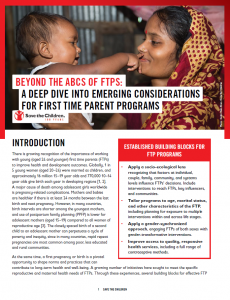
There is growing recognition of the importance of working with young (aged 24 and younger) first time parents (FTPs) to improve health and development outcomes. Globally, 1 in 5 young women (aged 20–24) were married as children, and approximately 16 million 15–19 year olds and 770,000 10–14 year olds give birth each year in developing regions [1, 2]. A major cause of death among adolescent girls worldwide is pregnancy-related complications. Mothers and babies are healthier if there is at least 24 months between the last birth and next pregnancy. However, in many countries, birth intervals are shorter among the youngest mothers, and use of postpartum family planning (PPFP) is lower for adolescent mothers (aged 15–19) compared to all women of reproductive age [3]. The closely spaced birth of a second child to an adolescent mother can perpetuate a cycle of poverty and inequity, since in many countries, rapid repeat pregnancies are most common among poor, less educated and rural communities.
At the same time, a first pregnancy or birth is a pivotal opportunity to shape norms and practices that can contribute to long-term health and well-being. A growing number of initiatives have sought to meet the specific reproductive and maternal health needs of FTPs. Through these experiences, several building blocks for effective FTP programming have emerged. However, as FTP programs advance, new learning and insights are rapidly emerging. To best meet the needs of FTPs, it is critical to capture these new insights and quickly apply them to programming and research. To support this, in 2018, the Bill & Melinda Gates Foundation commissioned Save the Children to conduct a review to examine new and emerging considerations from recent research and programs related to FTP’s reproductive and maternal health, with a particular focus on family planning (FP). This technical brief presents the main findings and considerations that emerged from the review.